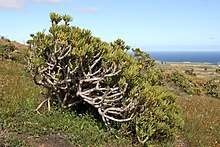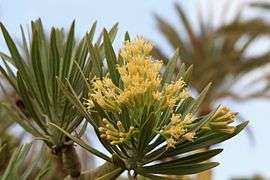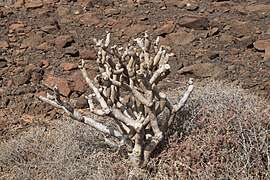Kleinia neriifolia
Kleinia neriifolia, known in Spanish as verode or berode, is a species of flowering plant in the daisy family (Asteraceae). It is endemic to the Canary Islands. It was formerly named Senecio kleinia.[2]:353
| Kleinia neriifolia | |
|---|---|
 | |
| Scientific classification | |
| Kingdom: | |
| (unranked): | |
| (unranked): | |
| (unranked): | |
| Order: | |
| Family: | |
| Subfamily: | |
| Tribe: | |
| Genus: | |
| Species: | K. neriifolia |
| Binomial name | |
| Kleinia neriifolia | |
 | |
| Native range of K. neriifolia. | |
| Synonyms | |
|
Senecio kleinia Less. | |
Description
A succulent plant,[3] Kleinia neriifolia has articulated branches (constrictions that make them look like rows of sausages)[4] and thick, stubby, elongated leaves which rest directly on the main stem or branch without a petiole or footstalk. The leaves grow clustered in crowded circles at the tops of the branches.[3] The trunk is about 1 m (3 ft) high, and the lanceolate leaves up to 12 cm (5 in) long.[4] Fragrant grey white flowers appear at any time between March and October. The plant is deciduous, the leaves falling at the beginning of the dry season.[5] As with most arid habitat plants, reproduction is by reseeding only.[3]
 Flowers
Flowers
 Leafless in the dry season
Leafless in the dry season
Habitat
Eugenius Warming, 1909[3]
Kleinia neriifolia grows abundantly in the Tabaibal-Cardonal zone or the arid, subtropical with steep and eroded substrates which are more pronounced and dominant in the eastern archipelago.[6] The vegetation can be compared with that of the arid areas of Sudan, Ethiopia, Arabia and Iran and is typical of the steppe in the African continent.[4]
Horticulture
The plant is used in gardens with dry conditions. The plant requires a minimum exposure of the sun. The minimum winter temperature it can endure is −2 °C (28 °F).[5]
Kleinia neriifolia has been successfully cultivated as a houseplant and as landscaping. It is on a list of suggested fire safe landscaping.[7]
References
- https://www.iucnredlist.org/species/79728152/79728158
- Bramwell, D.; Bramwell, Z. (2001). Wild flowers of the Canary Islands. Madrid, Spain: Editorial Rueda. ISBN 84-7207-129-4.
- Warming, Eugenius (1977) [1909]. "32 Storage of Water by Land Plants". Oecology of Plants. 300 Bedford Street, Manchester, NH: Ayer Publishing. ISBN 0-405-10423-5.CS1 maint: location (link)
- "Canary Islands Flora - Arid Habitat". Archived from the original on 2008-03-06. Retrieved 2008-03-02.
- Elio Darcangeli. "LE PIANTE - Senecio kleinia". PIANTE GRASS and SUCCULANTS (in Italian). Retrieved 2008-03-02.
- S. Rivas Goday y F. Esteve Chueca. "Ensayo fitosociológico de la "Crassi-Euphorbieta" macaronesica y estudio de los tabaibales y cardonales de Gran Canaria" (PDF). Anales del Jardín Botánico de Madrid (in Spanish). Real Jardín Botánico de Madrid: Real Jardín Botánico de Madrid. 22 (1): 221–339. Retrieved 2008-03-02.
- Jeanette Knutson-Pedersen; California Department of Forestry and Fire Protection (July 2005). "Tree Notes" (PDF). Fire Safe Landscaping. Plumas Fire Safe Council. Archived from the original (PDF) on 2008-05-10. Retrieved 2008-03-02.
External links
![]()
